This content was originally published on OldHouseOnline.com and has been republished here as part of a merger between our two businesses. All copy is presented here as it originally appeared there.
Having some peaceful greens to look at can really brighten up your home. But what would you do if you lived in a suburb without a garden space? Although there are quite a few ways to liven up your indoor space with a bunch of greens, one of the best ways is to grow your own plants with a grow light bulb. This bulb is a specially designed light bulb that helps plants grow indoors by providing the right amount of light that they need to photosynthesize. By using a grow light bulb, you can grow just about any type of plant indoors, regardless of the season or weather outside.
Although a relatively new innovation, the market has quickly been flooded with all sorts of grow light bulbs to choose from. In this article, we’ve compiled a list of some of the highest-rated grow light bulbs and will ensure that by the time you’re done reading, you’ll know exactly what you need to look for when shopping around.
Buyer Guide: Grow Light Bulbs
Although your options have been cut down by a lot, we still need to walk you through what you need to consider to ensure you make the best decision according to your grow light needs. Below is a buying guide with everything you need to consider before finalizing your purchase.
What Is a Grow Light Bulb?
A grow light bulb is a specially designed light bulb that simulates sunlight to help indoor plants grow. These bulbs come in various shapes, sizes, and colors, and each type is designed to provide different light intensity levels and spectrum.
What Are the Different Types of Grow Light Bulbs?
There are three main types of grow light bulbs: fluorescent, HID (high-intensity discharge), and LED (light-emitting diode). Each type has its own advantages and disadvantages, so here’s a little breakdown.
Fluorescent grow light bulbs
Fluorescent grow light bulbs are extremely common as they’re relatively inexpensive, easy to find, and come in various shapes and sizes. Most importantly, they emit a soft, diffused light ideal for seedlings and young plants.
The main downside of these bulbs is that they don’t produce as much light as HID or LED bulbs. They must also be replaced more frequently, typically every six months to a year.
HID grow light bulbs
HID grow light bulbs are considerably more powerful than their counterparts. They emit a bright, intense light that helps large plants and flowers. HID bulbs also last longer than fluorescent bulbs.
The downside of HID bulbs is that they’re more expensive than other types of grow light bulbs. They also produce a lot of heat, so you’ll need to use a fan or ventilation system to keep your plants from getting too hot.
LED grow light bulbs
LED grow light bulbs are the newest type of grow light bulb on the market. They’re more energy-efficient than other types and last longer. LED bulbs also produce very little heat, so you don’t need to worry about ventilation with these bulbs.
The downside of these bulbs is that they’re more expensive than other types of grow light bulbs. They also don’t produce as much light as HID bulbs, so they’re not ideal for large plants or flowers.
Uses of Grow Light Bulbs
- Starting seedlings: Grow light bulbs are ideal for starting seedlings because they emit a soft, diffused light that won’t damage delicate plants.
- Growing plants indoors: If you don’t have access to natural sunlight, grow light bulbs can provide the light your plants need to grow.
- Extending the growing season: Grow light bulbs can be used to extend the growing season by providing extra light to plants in the winter months.
How To Buy a Grow Bulb
Color temperature
The purpose of a grow bulb is to provide the light that will help plants grow; for that, they need to generate a particular color temperature. The ideal temperature is between 5,000 and 6,500 Kelvin. This color temperature can be found in both cool white and daylight bulbs. When picking a grow bulb, pay special attention to the color temperature listed on the packaging, as it will dictate whether the bulb is best suited for vegetative growth or flowering.
Lumens
Lumens measure the amount of light that is emitted by a grow bulb. When it comes to growing plants, you want a grow bulb with a high lumen output. This means that more light will be able to reach your plants, which will promote growth. Look for growing bulbs with an output of at least 3,000 lumens.
Watts
The wattage of a grow bulb measures how much energy it uses. As you might expect, higher-wattage bulbs will use more energy than lower-wattage bulbs. They will, however, also produce more light. When choosing a grow bulb, look for one with a wattage that is appropriate for your needs. A lower-wattage bulb will suffice if you are only growing a few plants.
Life span
Life span is another critical consideration when choosing a grow bulb. You want a bulb that will last for several growing seasons, so you don’t have to keep replacing it. Look for growing bulbs with a life span of at least 10,000 hours, as they will provide you with the most value for your money.
Heating
Some bulbs produce more heat than others, and this can be a problem if you are growing plants in a small space. If you are worried about heat buildup, look for bulbs that are labeled as “cool burning.“ These bulbs will produce less heat, making them safer for use in enclosed spaces.
Light color
Not many people are aware of this, but the color of light that a grow bulb emits can actually have an effect on plant growth. For example, blue light promotes vegetative growth, while red light is better for flowering. If you want to encourage growth in a particular area, look for growing bulbs that emit the color of light you need.
Safety
When growing plants indoors, choosing a grow bulb that is safe to use is important. Some grow bulbs emit high levels of ultraviolet (UV) light, which can harm your skin and eyes. If you use a grow bulb that emits UV light, wear protective clothing and accessories, such as gloves, goggles, and a long-sleeved shirt.
In addition to UV light, some grow bulbs emit high infrared (IR) light levels. While IR light is not harmful to your skin, it can harm your eyes. If you are using a grow bulb that emits IR light, make sure to wear protective goggles.
Finally, it is important to note that some bulbs produce a large amount of heat. If you use a grow bulb with a lot of heat, keep it away from your skin and any flammable materials.
Comparing the Top Grow Light Bulbs in Detail
Sansi Light Bulb
– Best Overall
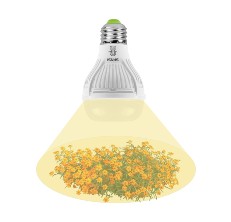
Looking for a grow light bulb that will make your plants flourish? The SANSI Grow Light Bulb is here to help! This innovative LED bulb is designed to provide supplemental light to your plants, and its frosted lens helps improve light utilization while providing even coverage. The 4000K daylight mimics natural sunlight, making it perfect for every stage of plant growth. And with a Color Rendering Index of 100, you can be sure that your plants will look their best. Plus, the Chip on Ceramic (COC) technology keeps things cool and prevents thermal resistance, ensuring that your plants get the most out of their light source.
These bulbs also have several safety features, including a V0 fire retardant grade and reinforced insulation to prevent electric shock. Plus, the entire shell is made from WF2 anti-corrosion material, making it durable and long-lasting. All these features combine and make for the best overall experience for you and your plants! And to top it all off, the SANSI Grow Light Bulb comes with a five-year warranty making it our best overall pick.
Pros
- Ceramic technology that helps in saving energy
- Has a PPF of 17.5 umol/s
- The LED light spectrum is full and customizable
- Covers a large area with a 120° beam
Cons
- It doesn’t come with a remote control
GE Lighting Light Bulb
– Most Versatile
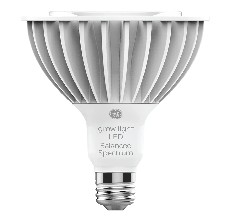
Time to take the matter into your own hands and bring your garden indoors with the GE Lighting Grow Light Bulb. This LED light is perfect for those who want to have a year-round garden or just show off their green thumb without harsh lighting. The PAR38 grow light bulb uses only 32 watts of energy, has a low heat output, and provides a natural light temperature that won’t disturb your home’s aesthetic. It also has a red and blue light spectrum, making it ideal for plants that need lots of light, like tomatoes, cucumbers, peppers, leafy greens, and herbs.
These bulbs are made to be extremely long-lasting, so all you need to do is set them up and let them do their job until your plants are ready to harvest. Additionally, it also features a high output PPF of 50 micromoles per second, making it one of the market’s most powerful grow light bulbs.
Pros
- Low energy usage
- Low heat output
- Long-lasting and durable
Cons
- Light might be intense for some plants
Briignite Light Bulb
– Longest Lasting
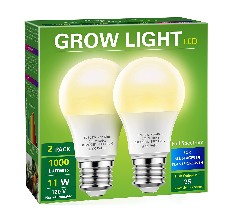
Bored of the same old light bulbs? Looking for something to help you bring out your plants’ true potential? Then look no further than the Briignite Grow Light Bulbs! Providing a full spectrum of light similar to natural sunlight, these bulbs are perfect for any stage of plant growth. What’s more, they consume just 11 watts of electricity while delivering 180 degrees of brightness – meaning you’ll see a 90% savings on your energy bill!
With a life span of up to 25,000 hours, these bulbs will keep your plants looking healthy and vibrant for years to come. Plus, their natural white light color won’t clash with your home’s decor. Additionally, their aluminum and plastic construction make for excellent heat dissipation. So why wait?
Pros
- 4,000K white light similar to natural sunlight
- Saves 90% on your energy bill
- Long life span of up to 25,000 hours
- Easy to install
Cons
- May be too bright for some plants
Miracle LED Light Bulb
– Easiest To Install
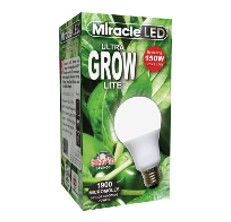
No more fumbling with light timers – the MiracleLED Grow Light Bulb has a wide 120-degree beam angle that covers more area than traditional grow lights so that you can say goodbye to fussy light timers and complicated wiring setups. With its easy installation clips, the Grow Lite can be mounted in seconds, giving you more time to focus on your plants.
The Miracle LED Commercial Hydroponic Grow Lite is the perfect way to start indoor gardening. Its full spectrum light at 5000K is ideal for plants and vegetables. This 12W LED replaces up to 150W and runs on extremely low power. The light is instant on, with no startup delay, and has virtually no heat signature, making it safe to use around your plants. These bulbs also come with a wide 120-degree beam angle that covers more area than traditional grow lights so that you can say goodbye to fussy light timers and complicated wiring setups.
Pros
- Ideal for plants and vegetables
- 5000K full spectrum light
- No startup delay
- Virtually no heat signature
Cons
- The price tag is a little steep
helloify Light Bulb
– Best Value
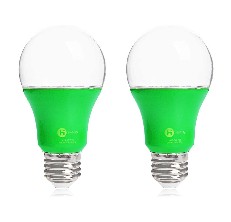
Looking to get into some serious horticulture but don’t want to fork over the cash for an expensive grow light? The helloify Grow Light Bulb just might be your savior! This bad boy emits 12 umol/s of red and blue light, which is perfect for photosynthesis. And since it’s an LED bulb, you can be sure it won’t hurt your eyes – or your plants. With a life span of 15,000 hours, the Helloify A19 LED Grow Light Bulb is an investment that will pay off for years to come.
These bulbs are made with supremely efficient LEDs and quality materials, so you can be sure that they won’t overheat – even if you use them for 24 hours straight! They’re also 80% more energy efficient than traditional bulbs, so you’ll save some serious cash in the long run. And since they have a wider light beam, they can also cover more plants – perfect for those colder months.
Pros
- Efficient LED light is ideal for photosynthesis
- Won’t hurt your eyes or plants
- Supremely energy efficient
- A wider light beam covers more area
Cons
- Light emitted may be intense for plants
People Also Asked
Q: How is a grow bulb different from a regular light bulb?
A: A grow bulb is a specialized light bulb that emits light at specific wavelengths beneficial for plant growth. Regular light bulbs emit a broader range of wavelengths, which can be less effective for plant growth or even harmful.
Q: Why is my grow light bulb consuming so much energy?
A: A grow light bulb may consume more energy than a regular light bulb because it needs to emit more light (at specific wavelengths) to be effective for plant growth. More efficient grow light bulbs are available that use less energy. Before making a purchase, compare the wattage of different grow light bulbs to find the most energy-efficient option.
Q: Can I paint over the bulb to change the light that comes from it?
A: It is not recommended to paint overgrown light bulbs because it can affect the light that comes from them. If you want to change the light that comes from a grow light bulb, it is best to buy a different bulb that emits the desired light.





